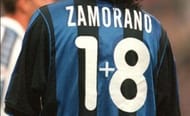Football is nothing if not a numbers game – the number of goals, the number of seconds on the clock, the number of points, the number of wins, the number of titles. And amidst all these numbers that dominate the game, sometimes, the most significant ones are those that are found on the back of the footballers’ jerseys, for these are the numbers that rule the masses, enthral the throngs of passionate supporters and ultimately define the legends of the game.
Fables and legends have been woven into these little symbols, legacies have been inherited, often burdening the bearer of the number. Yet, there are those who rise above such travails, attaching a greater significance and elevating the status of the number to a motif, an emblem, a regalia; one that is coveted and revered alike by the adoring partisans, thus forever establishing themselves in folklore.
What then, is in a number, one might be tempted to ask. Especially when one hasn’t spent countless hours on trying to convince football neophytes that the numbers on the shirts haven’t been randomly thrown around and that they are a throwback to a system that once existed, one that is seldom adhered to, unless one is conversing in tactical jargon, with the ‘False Nines’ and the ‘Out and Out Number 10′.
To understand the history and the origins behind the numbering of shirts, we first look at the ’2-3-5 Pyramid’ system that was predominant in British football in the Pre-First World War period. The system was based on three distinct rungs with the players’ roles defined in relation to the level they were placed in. The Right and Left Backs, the defenders, were entrusted with stopping the opposition forwards and rarely ventured up the pitch from their position. Further up the pitch, forming the second rung, were the Half Backs, those who were mainly involved in moving the ball forward rather than helping out in defense. The third rung comprised the attacking quintet consisting of the two traditional wingers who would run the channels and deliver crosses to the Centre Forward, while the two Inside Forwards, were the creative forces in the side.
Teams were usually announced with the goalkeeper at the top and the forwards at the bottom. In this format it was logical to hand out the shirts based on the order one read them off the team sheet. 1 for the goalkeeper, 2 and 3 for the full backs, 4, 5 and 6 for the half backs, and 7, 8, 9, 10 and 11 for the forwards. A simple system so that everyone knew what position they were playing and who they were supposed to mark. The numbering scheme was based on the standard right to left system of listing football teams.
The change to the offside rule saw the emergence of another tactic, the ‘W-M Formation’, which saw the Centre Half retreat into the defensive line, providing extra cover to the Full Backs. The Inside Forwards were also required to drop back into the midfield to aid the Half Backs in the middle of the pitch. This formation, if you haven’t discerned already, earned its name because of its appearance of a W sitting atop an M. The new nomenclature was then the 1-(2-5-3)-(4-6)-(8-10-7-9-11) system.
The more familiar 4-4-2 system developed independently in different parts of the world. Decades of variations based on tactics, technically demanding situations and the evolution of thought from a purely attack minded system to one which embraced attack and defense in a single formation saw the emergence of the 4-4-2.
The most striking characteristic of this system is the additional Half Back dropping into the defensive line, creating two Centre Halves. To counter the effects of leaving the midfield undermanned, the wingers were now required to track back and help out in defense. This eventually led to the wide players being asked to drop back into the midfield line, leaving the Inside Forward and the Centre Forward as the main attacking outlets.
The full backs push forward in attack to support the midfield while the centre backs tend to be defensive players who concentrate first on thwarting opposition forwards. The wingers are wide players who attack the opposition flanks, providing crosses to the forwards and creating space by stretching the opposition. The central midfield roles are usually defined as a holding type and an attacking counterpart. The forwards are usually given different roles, with the advanced forward either a poacher or an ‘out and out goalscorer’ assisted by the more creative play-maker.
The current system of numbering then, is derived from the 1-(2-5-6-3)-(7-4-8-11)-(9-10) format, one which tends to befuddle even the most ardent football aficionados, leaving them at a loss to explain the logic behind the numbering.
While numbering shirts first made its appearance in 1928 in a game between Arsenal and Sheffield Wednesday, it wasn’t until the 1990s that the mandatory 1-11 rule was abandoned and a more flexible squad numbering system was out into place. This has resulted in a numerous instances of comical, even bizarre shirt numbers. Indeed, who doesn’t remember Ivan Zamorano’s 1+8 jersey in response to his number 9 being given away to Ronaldo or Mathieu Flamini, Ronaldinho and Andriy Shevchenko donning the 84, 80 and 76 respectively in the 2008-09 season at AC Milan.
Shirt numbers have transcended generations of great players, the number 7 at Manchester United having seen George Best, Eric Cantona, David Beckham and Cristiano Ronaldo imprint their legacy on it. There are also those that define the legends of the game and have been retired when the players bow out of the limelight. Paolo Maldini’s number 3, the one he donned for 25 years at the San Siro was retired when the great man called it time. More recently, Schalke retired their number 7 when Raul announced his departure from the side.
Every number has a story behind it, quirks and idiosyncrasies of footballers are tied into the tales and there is a certain humor that can be found, if one looks for it.
To quote Joe Paterno: “It’s the name on the front of the jersey that matters most, not the one on the back.”. The number merely adds to the charm, one might add.


